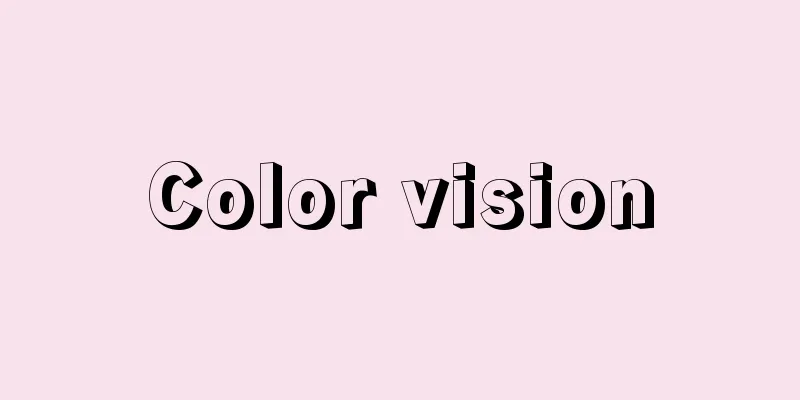Color vision

|
This refers to the qualitative difference in vision caused by light of different wavelengths or a mixture of these. Humans can see light with wavelengths between about 800 and 400 nanometers in the solar spectrum (visible light), and can sense roughly seven different colors according to the range of wavelengths. [Masamichi Ichioka] Color perceptionColor vision occurs through the cones, which are photoreceptor cells in the retina. Humans have three types of cones, each with pigments that are most sensitive to blue, green, and yellow wavelengths. Of these, the cones that are most sensitive to yellow are also quite sensitive to red light. In this way, the human retina can be said to have a mechanism that is highly sensitive to three types of colored light: blue, green, and yellow-red, which roughly correspond to the "three primary colors of light." Furthermore, it is known that there are many cells in the visual cortex that respond most strongly to blue, green, and orange-red wavelengths. It is thought that color is perceived by the pattern of afferent nerve impulses (action potentials) from the three cone systems and the excitation patterns of three types of nerve cell groups in the visual cortex. [Masamichi Ichioka] Three attributes of color visionColor vision has three attributes: hue (or simply color, or tone), lightness, and saturation (or chroma). Hue is an attribute determined by the wavelength of the stimulating light, and in the sunlight spectrum, it is roughly divided into seven types: red (approximately 723-647 nanometers), orange, yellow, green (approximately 575-492 nanometers), blue (approximately 492-450 nanometers), indigo, and violet. However, there are slight differences in the data of researchers regarding the wavelengths of sunlight that correspond to hues. The total number of hues depends on the number of minimum wavelength differences that can be distinguished, and is thought to be about 165 types in humans. Lightness is the degree of brightness, and is divided into 11 levels from black to white. Saturation refers to the amount of white mixed into a color; the more white is mixed in, the less vivid the color becomes and the less saturated it becomes. If each of the 165 hues is further divided by lightness and saturation, the number of "hues" would reach hundreds of thousands. [Masamichi Ichioka] Mixing Color LightWhen two or more monochromatic lights are applied to the same part of the retina, we perceive a mixed color that is different from the stimulating light. This is a sensation of color caused by the overlap of two or more physiological processes. The following is known about the mixing of such monochromatic lights: (1) When all monochromatic light is mixed together, it becomes white. (2) The further apart the two colors are in the spectrum, the less saturated the mixture will be, until the mixture of two colors produces white. Such two colors are called the complements of each other, for example, red-blue-green, yellow-indigo-blue, green-yellow-purple, etc. (3) If you mix purple and red, which are at opposite ends of the spectrum, you get purple, which is not in the spectrum. (4) Any color can be obtained by mixing a small number of monochromatic lights in various proportions. To create any color, at least three colors, red, green, and blue, are required, so these are called the "primary colors." [Masamichi Ichioka] Afterimage and ContrastIn color vision, phenomena such as afterimages and contrast can be observed. An afterimage is the sensation of light that remains after a light stimulus has disappeared, and contrast is when two characteristics stand out through a comparison. Among afterimages, an afterimage of the same color is called a positive afterimage, and an afterimage of a complementary color is called a negative afterimage. In contrast, complementary colors can appear and the saturation can change. Among color vision deficiencies, red-green color blindness is a sex-linked recessive genetic disorder, affecting approximately 8% of men and 0.5% of women in Europe and the United States, and approximately 4-5% of men and 0.2% of women in Japan. The most common type is deuteranopia (formerly known as protanopia), followed by deuteranopia (formerly known as protanopia), followed by type 1 ditanopia (formerly known as protanopia), and type 1 tritanopia (formerly known as protanopia). [Masamichi Ichioka] Color vision in animalsSome animals other than humans have the ability to distinguish between different wavelengths of light, i.e., color vision (also called color sensation). However, the content of color vision varies considerably from animal to animal. In vertebrates, it is the cones in the retina that are involved in color vision, while the rods are involved only in light and dark vision. Therefore, by examining the ratio of cones to rods in the retina, we can get a rough idea of the level of color vision an animal has. Birds have the most developed cone-based vision. The retina of diurnal birds, especially in the central part, is densely packed with cones, and has few rods that can sense weak light. As a result, many birds are so-called night-blind, losing their vision in dim light. However, some nocturnal birds, such as owls, have developed dark vision but have few cones and therefore no color vision. Reptiles, such as snakes, turtles, and lizards, also have well-developed color vision. The fact that bony fish have color vision is shown by the presence of cones in the retina, the presence of cells that respond differently to different wavelengths of light, and their behavior in response to certain colors. However, cartilaginous fish, including sharks and rays, do not have cones, with a few exceptions, and therefore no color vision. Amphibians, such as frogs and newts, have cones and have color vision, but it is only poorly developed. Generally speaking, nocturnal animals do not have color vision. Mammals are generally considered to have no color vision, which is said to be because their ancestors were nocturnal. Primates such as humans and monkeys have well-developed color vision, but they are rather the exception; only a few mammals, such as dogs, cats, and pigs, have weak color vision. Some invertebrates also have developed color vision. Arthropods, especially insects, have advanced color vision, and the color vision of honeybees and fruit flies is well known through many behavioral and electrophysiological studies. The visible light range of honeybees and other insects is shifted to the shorter wavelength side than that of humans, and they can distinguish three colors, including ultraviolet, which is invisible to the human eye, but they cannot see long-wavelength light, which appears red to humans. However, swallowtail butterflies have six types of photoreceptors with different spectral sensitivities and can see red. Some nocturnal insects do not have color vision. Cephalopods, mollusks such as squids and octopuses, have well-developed eyes and can quickly change their body color depending on the color of their surroundings. However, the results of studies examining the electrical responses recorded from the retina and behavior have shown that cephalopods do not have color vision. [Akira Murakami] [References] | | | |Source: Shogakukan Encyclopedia Nipponica About Encyclopedia Nipponica Information | Legend |
|
異なる波長の光、またはその混合によっておこる視覚の質的差をいう。ヒトは太陽光線スペクトルのうち約800~400ナノメートルの波長の光線を見ることができ(可視光線)、波長の範囲に応じて大別して約7種の色を感じることができる。 [市岡正道] 色の認知機序色覚は、網膜中の視細胞である錐状体(すいじょうたい)(錐体)を通しておこる。ヒトには青、緑、黄の波長に対してそれぞれもっとも感受性の高い色素をもった3種の錐状体がある。このうち黄に対して最大感度を示す錐状体は、赤の部分の光に対しても十分感度がよい。このようにヒトの網膜には、「光の三原色」にほぼ相当する青、緑、黄‐赤という3種の色光によく感ずる機構が備わっているといえる。さらに大脳皮質視覚領には青、緑、橙(だいだい)‐赤の波長に対して最大の反応をする細胞が多数あることがわかっている。色は、三つの錐状体系からの求心性神経インパルス(活動電位)のパターンpatternと皮質視覚領の3種の神経細胞群の興奮パターン等によって認知されるものと考えられる。 [市岡正道] 色覚の三つの属性色覚には、色相(または単に色、あるいは色調)、明度、飽和度(または彩度)の三つの属性がある。色相は刺激光の波長によって決められる属性で、太陽光線のスペクトルではおおよそ赤(約723~647ナノメートル)、橙、黄、緑(約575~492ナノメートル)、青(約492~450ナノメートル)、藍(あい)、紫の7種に大別される。しかし、色相に対応する太陽光線の波長は研究者のデータに若干の違いが認められる。色相の総数は弁別できる最小波長差の数の多少によるわけで、ヒトの場合で約165種とされている。 明度とは明るさの度合いで、黒から白まで11段階に分けられている。また、飽和度とはある色に白の混じる度合いをいい、白が多く混じるほど鮮やかさは失われて飽和度が低くなる。165種の色相のそれぞれを明度と飽和度とで細区分すると、「色合い」の種類は数十万に達することになる。 [市岡正道] 色光の混合二つ以上の単色光で網膜の同一部位を刺激すると、刺激光とは異なった混合色を感じる。これは二つ以上の生理学的過程が重なっておこった色の感覚である。このような単色光の混合においては次のことが知られている。 (1)すべての単色光を混合すると白になる。 (2)混合する2色がスペクトルのうえで離れているほど混合色の飽和度が低下し、ついにはある2色を混ぜると白になる。このような2色を互いに他の補色という。たとえば赤‐青緑、黄‐インディゴ青、緑黄‐紫などである。 (3)スペクトルの両端にある紫と赤とを混ぜると、スペクトル中にはない紫紅(しこう)ができる。 (4)少数の単色光をいろいろな割合で混ぜると任意の色が得られる。こうした任意の色をつくるには少なくとも赤、緑、青の3色が必要とされるため、これを「色の三原色」という。 [市岡正道] 残像と対比色覚においては残像や対比という現象がみられる。残像とは光刺激が消失したあとに残る光の感覚をいい、対比とは比較によって二つの性質の特徴が目だつことをいう。残像のうち、同色の残像を陽性残像、補色の残像を陰性残像とよぶ。また、対比では補色がみられたり、飽和度が変化したりする。 なお、色覚異常のうち赤緑色覚異常は伴性劣性の遺伝で、欧米では男性の約8%、女性の約0.5%、日本では男性の約4~5%、女性の約0.2%を占めている。2型三色覚(旧称は緑色弱)、次いで2型二色覚(旧称は緑色盲)が多く、1型二色覚(旧称は赤色盲)、1型三色覚(旧称は赤色弱)が順に続いている。 [市岡正道] 動物の色覚ヒト以外の動物でも、異なる波長の光を識別する能力すなわち色覚(色感覚(いろかんかく)ともいう)をもつものがある。しかし、その色覚の内容は、動物によってかなり異なっている。脊椎(せきつい)動物の場合、色彩視に関係するのは網膜中の錐状体(すいじょうたい)であり、桿状体(かんじょうたい)は明暗視のみにかかわっている。このため、網膜にある錐状体と桿状体の割合を調べることによって、その動物がどの程度の色覚をもつかおおよその見当をつけることができる。 錐状体による視覚がもっとも発達しているのは鳥類である。昼行性の鳥類の網膜、とくにその中央部分には錐状体が密集しており、弱い光にも感じうる桿状体はほとんどない。そのため、多くの鳥は薄暗がりの中で視力を失ういわゆる鳥目である。しかし、フクロウのような夜行性の鳥には、発達した暗所視をするがほとんど錐状体をもたないため色覚がないものがある。ヘビ、カメ、トカゲなどの爬虫(はちゅう)類にも色彩視がよく発達している。硬骨魚類に色覚があることは、網膜中に錐状体があり、また異なる波長の光に異なる応答をする細胞があること、さらに特定の色に対する行動などからも示されている。しかし、サメ、エイを含む軟骨魚類には、いくつかの例外を除いて錐状体がなく、色覚はない。カエル、イモリなどの両生類には錐状体があり、色覚があるが発達の程度は低い。一般的にいって夜行性の動物には色覚がない。哺乳(ほにゅう)類は原則として色覚がないとされるが、それは哺乳類の祖先が夜行性であったためといわれる。ヒトやサルなどの霊長類は発達した色覚をもつが、これはむしろ例外であり、イヌ、ネコ、ブタなど幾種かの哺乳類に弱い色彩視が認められるにすぎない。 無脊椎動物にも発達した色彩視をするものがある。節足動物、とくに昆虫類には高度の色覚があり、行動の解析や電気生理学的な多くの研究により、ミツバチやショウジョウバエなどの色覚がよく知られている。ミツバチなどの可視光の範囲は、ヒトのものよりも短波長側にずれており、ヒトの目に見えない紫外部を含む3色を区別することができるが、ヒトには赤色に見える長波長側の光を見ることができない。しかし、アゲハチョウには6種類もの分光感度の異なる視細胞があり、赤色を見ることができる。夜行性の昆虫には、色覚をもたないものがある。イカやタコなど軟体動物の頭足類は、よく発達した目をもち、周囲の色に応じてすばやく体色変化をする。しかし、網膜から記録される電気的反応や、行動を調べた研究の結果は、頭足類が色覚をもたないことを示している。 [村上 彰] [参照項目] | | | |出典 小学館 日本大百科全書(ニッポニカ)日本大百科全書(ニッポニカ)について 情報 | 凡例 |
>>: Magnetic Chemistry - Magnetic Chemistry
Recommend
Iwamurada
Located in eastern Nagano Prefecture, this is one ...
Taeuber-Arp, S. (English)
…The painter P. Klee, the sculptor A. Giacometti,...
Shojuraikoji Temple
This Tendai sect temple is located in Hieitsuji, ...
Okabe Rokudayu
…(1) The Musashi Seven Clans, Ono Family, Inomata...
Balintang Channel
…A large strait about 350 km wide between the Phi...
Tsuruhachi Tsurujiro - Tsuruhachi Tsurujiro
A shinpa play by Kawaguchi Shotaro. The original ...
Statistics - statistics
A variable that takes on various values accordin...
Under What Stars?
...At the time, he insisted on his own eloquent s...
Otamaya - Otamaya
〘 noun 〙 ("o" is a prefix) A hall where ...
robe décolletée (English spelling) robe de colletee
…The Western-style uniform system was established...
Horned stink bug (horned stink bug) - acanthosomatid bug
A general term for insects of the Hemiptera family...
Rosser, JB
…In 1931, K. Gödel introduced a technique called ...
Xuzhou Operation
From April 7 to May 19, 1938, the Japanese army pi...
Tractor
…The form of capital was often in the form of phy...
Edo School
〘 noun 〙 A school that was active in Edo. ① A scho...

![Matsusaka [city] - Matsusaka](/upload/images/67cce7282e707.webp)







